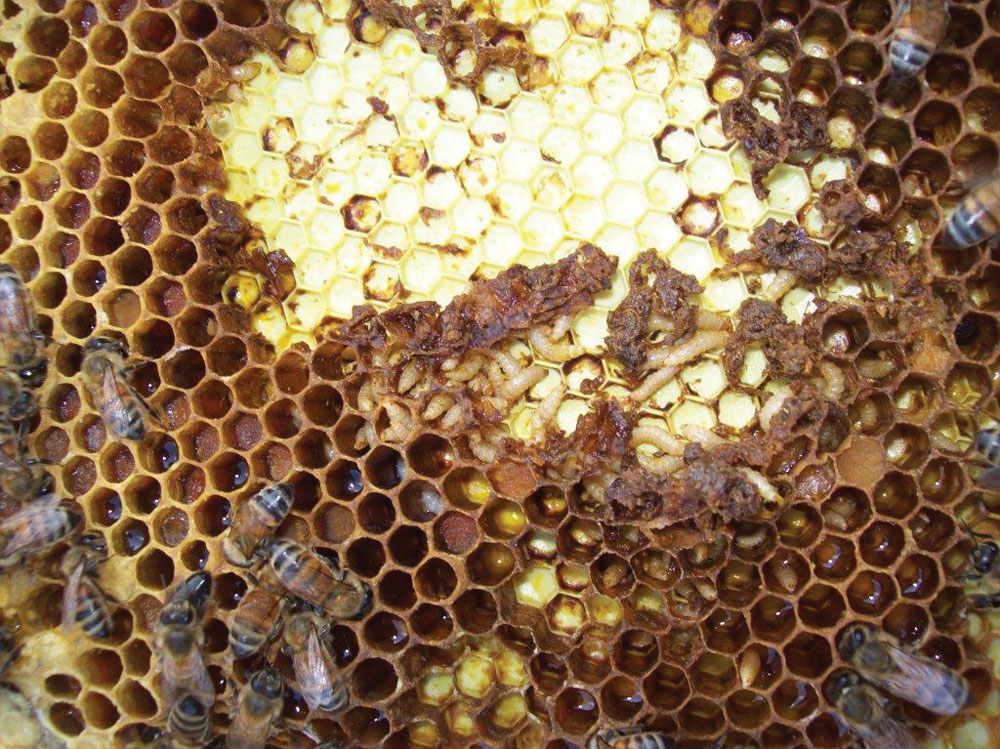I investigated several episodes of significant colony losses in Mississippi during the last year, and in almost all cases colony demise stemmed from failure to control Varroa mites below damaging levels.
However, there were several instances in which this conclusion was not based on observed evidence simply because the dead empty hives retained nothing to implicate the cause of death. As with all inquiries that I make, the client suffers through an interview about management practices, and high on the list are the inevitable questions about management of Varroa mites. I investigated at least 12 episodes that spanned late Summer into early Winter – and all of the clients either elected to do nothing to control Varroa mites or they used techniques that could not possibly control the mites. Collectively, these dozen people lost > 900 colonies to Varroa mites. These losses disturb me because we are now well into the 3rd decade of dealing with this key pest in the U.S., and people should have more sophistication and savvy in dealing with it.
The frustration of losing colonies to mites and finding colonies slimed by the subsequent Small Hive Beetle (SHB) infestation generates pain and anger from anyone who loves their bees. The first battle to fight with some clients is to convince them that SHB probably did not kill your colonies. I see the clinched teeth and strained faces as we examine the lost and slimed colonies looking for the culprit. I have heard beekeepers say, “The next time Harris tells me that SHB did not kill my colonies, I’m gonna punch him.” I stay firm and suggest that something besides SHB killed the bees, and it is the SHB preying on severely compromised colonies that is the final insult of which we bear witness. Some beekeepers become indignant and deny the possibility that Varroa mites were the real problem.

This many Varroa in worker cells means this colony is already dead – it just doesn’t know it yet.
(USDA photo)
For example, one client actually said, “I do not have varroa mites now, and I have never seen them in my colonies!” We were looking at 200 dead colonies from a total of 400 during mid-Summer when the honey crop should have been extracted. I asked how he managed Varroa mites. He had done nothing EVER to manage the mites. He declared that he never wanted to contaminate his hives with pesticides, and so he elected not to use chemical controls for the mite. I asked if he had ever sampled to see what mite levels were reached in his colonies, and he declared in a shaky voice, “Yes! I used sticky boards just this spring, and I saw NO mites on the boards.” I was slightly dumbfounded because the level of colony loss should have been preceded by at least some mites dropping on sticky boards.
It was not until much later during the day when I saw that the man had trouble reading from a slip of paper, and I wondered if he simply did not see the mites because of failing vision. I did not want to insult him with such a suggestion, so I asked if I could return the next day with a stereomicroscope to examine brood combs from his remaining hives to look for the mite infestation levels. He agreed that this was indeed a good idea. Early the next day I asked him to pick colonies at random from his survivors, and we removed combs with capped brood and took them back to his shop where I had set up a stereomicroscope on a boom stand with a bright light source. I did not need the scope to see that the combs were heavily infested. I could see mite feces on the walls of brood cells where worker bees had recently emerged, and I had already pointed out significant levels of workers with deformed wings while we were in the field collecting the combs. I found mites in every one or two worker brood cells that were examined – suggesting extremely high and potentially lethal levels. I yielded the microscope to the client and watched as the reality of the high mite infestation registered across his face. He looked up from the scope after examining about a dozen brood cells and said, “I guess you’re right, the mites are killing my bees.” Such a response saddens me more than it gives me a feeling of vindication.
I now routinely carry the microscope with me when investigating colony losses. Many folks need to see before accepting my conclusions. The previous client was actually a fairly new beekeeper of only four to five years. He chose not to treat for mites, and I understand completely the desire to avoid contaminating hives with miticides. Beekeepers have the right to choose the path of not treating, but they should understand that if they do nothing, colonies will be lost to varroa mites. It may not happen this year or next year, but when it does occur, it could be a large proportion of the colonies that are being kept.
I have written about this attitude in previous articles, but it deserves some attention even now. If a beekeeper can accept episodes of high colony losses, then this approach does guarantee that the beekeeper is not contaminating his own hives. I still encourage these beekeepers to DO SOMETHING. Increase the distance between hives in apiaries. Increase the distance between apiaries. Do anything to reduce the drift or movement of mites between colonies. Implement some kind of brood break to slow the growth of mite populations. Allow swarming as a form of natural brood break. Use a Varroa -resistant stock of bees. Use drone-trapping, if feasible.
A second example occurred within two weeks of the previous event. This encounter disturbed me more because the client claimed to be a beekeeper with more than 30 years of experience. He was managing somewhere near 1,000 colonies, and at least 40% of them were dying (and many of those were being destroyed by SHB and/or the larvae of Greater Wax Moths when I drove up in my truck). As is usual, I asked about his methods for control of Varroa. He said, “I have been controlling Varroa mites with beef suet placed in the colonies.” He seemed confident of the technique, and I was more than a little perplexed about his choice of control. What made him think that beef suet would work?
Then it occurred to me that he may have confused the use of grease patties, which is an effective treatment for the Honey Bee Tracheal Mite (HBTM), as an effective alternative for varroa mites. After a few questions, I decided that he simply misunderstood and made a huge mistake. As with the previous client, it took me showing him highly infected worker brood from his survivors to make the claim of Varroa mites plausible. I recently inquired about the fate of the remaining colonies, and the man is no longer in business as a beekeeper.
These first two clients were people earning at least some of their income for bees. I expect these guys to be a little more capable than some of the small scale beekeepers or hobbyists. I often find small scale beekeepers that have made a similar decision to not use chemicals in their hives. Some folks are pretty forceful in suggesting that this is the way that all beekeepers should operate, after all, they have been running bees chemical-free for years and have not suffered catastrophic losses. I often tell these beekeepers that they must be using management techniques that help slow the growth of mite populations, or they are fairly isolated from other beekeepers, or they have simply been lucky.
I remember one husband and wife team that proudly showed me their 20+ colonies in their suburban yard. The colonies looked strong and healthy upon my first visit. I asked how they managed Varroa mites, and they promptly told me that they did not use chemicals, and their bees were doing just fine, thank you very much. I encouraged them to use an IPM approach to manage Varroa mites. I asked them to at least consider adding drone trapping or a resistant stock to their beekeeping repertoire. They politely declined and said that they had kept bees without controlling varroa mites for eight years, and they saw no reason to change now. I just shook my head and wished them the best.
About 1.5 years later they called me in December to say that something terrible had happened to their bees. I immediately drove to their house and surveyed the bees. Starvation was not an issue. All of the dead colonies (more than half of their full complement) had plenty of Winter honey stores in the top supers. There were not huge piles of dead bees on the bottom boards. Most colonies had either no bees or only a handful of bees and a queen trying to survive. I said that without any evidence, my best guess was Varroa mites. The husband responded, “Dude, you always see Varroa mites as the problem…!” I said that my summation was simply a guess based on my knowledge that they were not controlling the mites and my many years of experience in culturing mites in field experiments. I explained that I had seen plenty of colonies die during the Winter in much the same way as his colonies after I had purposely grown mites to high levels in the colonies for research purposes. I admitted that I could be wrong, but with no other evidence or symptoms and the knowledge of lack of Varroa management, my guess was not unreasonable. They seem stubbornly resistant to the idea that Varroa mites killed their bees when I finally left them.
Finally, I will relay a more recent encounter with a client that just left me scratching my head in disbelief. This particular client had 30 colonies in an apiary located in a fairly idealized bee forage area, and the apiary was far removed from other beekeepers. I had talked to the beekeeper on previous occasions and knew that he was not opposed to chemical control of varroa mites, but he did not want to practice regimented use of chemicals. Instead, he wanted to sample his colonies to make his treatment decisions. On at least three occasions, we talked about sampling and action thresholds to use in making these treatment decisions. He told me that he would collect samples from all colonies, and because the alcohol wash was more reliable, it would be the method of choice to dislodge and count the mites from his samples. His plan was to collect samples in Ziploc bags and hold them in a freezer until a rainy day kept him from doing other field work, and he would wash the samples to determine the mite loads. Confident that the man had a reasonable plan, I forgot about him and just knew he would have few problems ahead if he would just stick to some kind of IPM approach.
I happened to run into the beekeeper at a Winter commodity meeting and asked how his bees were doing. His face turned a little red, and he said, “Not so good. I lost 27 out of 30.” My mouth hung open for several moments as I struggled with what to say next. I said, “You’re kidding me, right?” He did not answer and the solemn look on his face told me that he was not. I asked what killed the bees, and he responded that he did not know, but all of the losses occurred in the early to mid-Winter period. He reported that all dead colonies had full supers on top of the empty brood chambers. “What were your Varroa mite levels in late Summer after taking the honey off?” I asked. He explained that he did not take the samples in July or August, but he did take samples from all colonies in October just before the colonies went broodless for the Winter. “Well, what were your levels then?” I persisted. He told me that he did not know because he had not counted the mites yet; the samples were still in the freezer. He explained that he just got busy and forgot to wash the samples. He felt like his colonies were really strong going into the Winter, and the Varroa mite issue was probably not a problem. I just slapped my forehead in disbelief.
I told the beekeeper that it would be nice to examine the samples to at least see if mite levels were as low as he presumed. He counted the mites and bees in his samples in February, and he reported a mean infestation level of 18% (that is 18 mites per hundred bees) for all 30 colonies. His average number of bees per sample was 350 worker bees. The five living colonies had a range of 1-5% infestation level of the adult worker bees, while the 27 dead ones had a range of 12-80% infestation level. Those numbers tell more than I could ever tell the beekeeper.
One could argue that the near broodless conditions of his hives in October led to an inflated infestation rate on the adult bees. This is true; however, a mean of 18% is horrendous under any condition. If his bee clusters averaged at least 40,000 – 50,000 bees going into the Winter, the total mite load was at least 7,200 – 9,000 mites. These levels are well above damaging levels, and there should be no surprise that the bees died.
Even if a large percentage of these mites were to die in the Winter, the bees that were expected to overwinter were greatly compromised by fostering such a large population of mites in the late Summer and early Autumn brood rearing periods. I can only presume that many of these bees (thousands) could have been compromised by the viruses that are vectored by Varroa mites. These bees probably had reduced lifespans, and the Winter cluster fell apart as sick bees dwindled from the group.
The lessons to be learned here are not new. I just wish the learning curve was not so steep. I will continue to push folks to consider managing Varroa mites in better ways – but for the life of me, I cannot make people follow through and examine the samples once they have been taken. I do not wish to poke fun at the fellow who did not examine the samples until after his bees were dead, but his situation provides strong evidence that sometimes I know what I am talking about. There is one thing that I know more than a little about, and that thing is the Varroa mite. My understanding has only come from 20 years of working with the beast, and it would be nice to use that knowledge to save other beekeepers from the grief of disproportionate colony losses. I hope my stubbornness is stronger than the resistance that some beekeepers have to learning how to better manage the mites. Sometimes I wonder . . .
Jeff Harris is the Extension/Research apiculturist in the Department of Entomology at MS State University.











